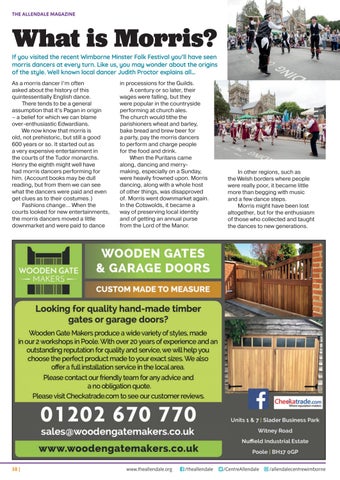THE ALLENDALE MAGAZINE
What is Morris?
If you visited the recent Wimborne Minster Folk Festival you’ll have seen morris dancers at every turn. Like us, you may wonder about the origins of the style. Well known local dancer Judith Proctor explains all… As a morris dancer I’m often asked about the history of this quintessentially English dance. There tends to be a general assumption that it’s Pagan in origin – a belief for which we can blame over-enthusiastic Edwardians. We now know that morris is old, not prehistoric, but still a good 600 years or so. It started out as a very expensive entertainment in the courts of the Tudor monarchs. Henry the eighth might well have had morris dancers performing for him. (Account books may be dull reading, but from them we can see what the dancers were paid and even get clues as to their costumes.) Fashions change… When the courts looked for new entertainments, the morris dancers moved a little downmarket and were paid to dance
38 |
in processions for the Guilds. A century or so later, their wages were falling, but they were popular in the countryside performing at church ales. The church would tithe the parishioners wheat and barley, bake bread and brew beer for a party, pay the morris dancers to perform and charge people for the food and drink. When the Puritans came along, dancing and merrymaking, especially on a Sunday, were heavily frowned upon. Morris dancing, along with a whole host of other things, was disapproved of. Morris went downmarket again. In the Cotswolds, it became a way of preserving local identity and of getting an annual purse from the Lord of the Manor.
www.theallendale.org
/theallendale
In other regions, such as the Welsh borders where people were really poor, it became little more than begging with music and a few dance steps. Morris might have been lost altogether, but for the enthusiasm of those who collected and taught the dances to new generations.
/CentreAllendale
/allendalecentrewimborne













